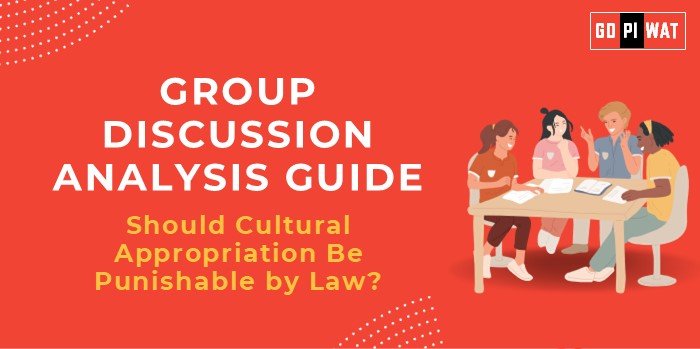📋 Group Discussion (GD) Analysis Guide: Should Cultural Appropriation Be Punishable by Law?
🌐 Introduction to the Topic
- 📖 Opening Context: Cultural appropriation, defined as the adoption of elements from one culture by members of another, has sparked widespread debates. While seen by some as cultural exchange, others argue it perpetuates inequality and disrespects marginalized cultures. The question of legally punishing cultural appropriation raises concerns about cultural preservation, freedom of expression, and societal unity.
- 📜 Topic Background: Originally debated in academic circles, cultural appropriation gained mainstream attention through cases involving fashion, art, and music. Recent controversies have highlighted incidents where individuals and companies profited from cultural symbols without acknowledging their origins or significance, prompting some advocates to call for legal recourse to prevent exploitation.
📊 Quick Facts and Key Statistics
- 🌍 Globalization Impact: 3.6% of global GDP attributed to cultural and creative industries, underlining economic potential and sensitivity.
- 👗 Fashion Industry: 67% of cultural symbols used in global fashion lack formal credit to originating cultures, indicating frequent appropriation.
- ⚖️ Legal Measures Worldwide: France and Canada have frameworks to protect indigenous art forms, emphasizing cultural respect.
- 📜 Cultural Heritage Laws: 48 countries have laws to protect indigenous heritage, though these laws seldom cover modern cultural appropriation.
🔍 Stakeholders and Their Roles
- 🏺 Cultural Communities: Custodians of cultural symbols, who often seek recognition and protection of their heritage.
- 🏛️ Governments: Could legislate and enforce laws to protect cultural property rights.
- 🎨 Creative Industries: Major users of cultural symbols, both contributing to and sometimes benefiting from cultural appropriation.
- ⚖️ Legal Experts and Advocacy Groups: Seek balanced regulations that respect cultural heritage while allowing creative freedom.
📈 Achievements and Challenges
- 🌟 Achievements:
- Increased Awareness: Social media and global forums have raised awareness of cultural appropriation issues.
- Protective Laws: Some indigenous communities, such as in Canada, have successfully enacted laws protecting traditional symbols.
- Ethical Fashion Movement: Brands like Stella McCartney emphasize sustainable practices that respect cultural origins, encouraging industry-wide adoption.
- ⚖️ Challenges:
- Lack of Clear Boundaries: Defining when cultural exchange becomes appropriation is subjective.
- Legal Ambiguity: Current laws often do not cover non-tangible cultural elements.
- Balancing Free Expression: Restricting cultural use risks limiting freedom in creative fields.
- 🌍 Global Comparisons:
- France: Provides legal protection for cultural elements through its UNESCO initiatives.
- Australia: Legally protects Aboriginal symbols, though enforcement varies.
- 📖 Case Studies:
- Native American Art in the U.S.: Protected under the Indian Arts and Crafts Act, though instances of violation persist.
💡 Structured Arguments for Discussion
- ✅ Supporting Stance: “Legally penalizing cultural appropriation would protect marginalized cultures from exploitation and encourage respect for diversity.”
- ❌ Opposing Stance: “Legal punishments for cultural appropriation risk stifling artistic freedom and may be impractical to enforce consistently.”
- ⚖️ Balanced Perspective: “While punitive measures may not be feasible, stricter guidelines and cultural education could foster respect without limiting creativity.”
🚀 Effective Discussion Approaches
- 📊 Opening Approaches:
- Historical Contrast: Start with examples of cultural items, like Native American headdresses, being misappropriated in fashion.
- Statistics-Driven: Cite statistics on the economic impact of cultural industries to stress the importance of cultural respect.
- Legal Precedents: Reference protective laws in countries like Australia to establish potential frameworks.
- 🔄 Counter-Argument Handling: Emphasize the importance of respecting artistic expression while advocating for ethical use. Use examples of successful ethical practices in creative fields as counterpoints.
⚙️ Strategic Analysis of Strengths and Weaknesses
- 🌟 Strengths:
- Protects marginalized cultures
- Encourages responsible use
- Reduces exploitation
- ⚠️ Weaknesses:
- Difficult to define appropriation objectively
- Potential to limit cultural exchange
- 🌱 Opportunities:
- Increased cultural awareness and inclusion
- Potential for ethical collaborations
- ⚡ Threats:
- Risk of censorship
- Backlash from creative industries
📚 Connecting with B-School Applications
- 🌐 Real-World Applications: The topic highlights complex intersections of ethics, branding, and international law, applicable in fields like international business, corporate social responsibility, and marketing.
- 📋 Sample Interview Questions:
- “How can businesses respect cultural symbols while encouraging diversity?”
- “Do you believe punitive measures for cultural appropriation are effective in promoting social harmony?”
- 🎓 Insights for B-School Students: Embrace ethical frameworks, understand the impact of branding on cultural sensitivity, and learn from case studies on cultural respect.


